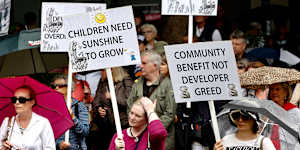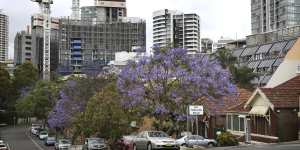Greg Clark – who has advised London,New York,Barcelona,Moscow,Hong Kong and Auckland on strategic planning – said councils needed tax incentives to grow their constituencies,as they have “accidentally and unintentionally become the force of resistance to growth”.

A community protest against so-called overdevelopment on Sydney’s lower north shore in 2019.Dean Sewell
“Local government is extremely weak in Australia,probably one of the weakest local government systems in the whole of the OECD,” he said. “Local government in Australia doesn’t feel the benefit of population growth through the tax system.”
While there had been some reform,including the previous Liberal government’s botched attempt to amalgamate councils,Clark said it had not been sufficient to give councils the needed incentives or the confidence that money for transport,amenities and public space would follow.
“You need local government that has skin in the game. That probably means a smaller number[of] but much more powerful local governments with more financial autonomy,” he said.
“Around the world,governments have realised that if you maintain a weak local government,one where there isn’t skin in the game,where they don’t benefit financially from development ... then they tend to resist it.”

“In most big cities,public land is the secret weapon in tackling the housing supply challenge,” says urbanist Greg Clark.Steven Siewert
Clark advised the former NSW government on creating the Greater Sydney Commission,now the Greater Cities Commission. He spoke to theHerald on the sidelines of the Property Council’s Future Cities summit,where speakers echoed his concerns about the failure of state and local governments to co-operate on housing supply.
Carolyn Viney,chief executive of finance vehicle Super Housing Partnerships,said she suspected many councils were “sorely hoping someone disconnects their electability from the strategic need that they witness in their own communities” to increase density.
“There’s no cause and effect at the moment,or reward,for doing the right thing. There’s some consistency about how people are penalised for not carrying their fair share,and there should be something of a reward for people who do the right thing as well.”
Panel moderator Kate Meyrick,a director at Urbis,said,“Quite frankly,we should take all those councils on a trip to San Francisco in the winter and let them walk down Powell Street and step over the bodies of the homeless people sleeping in sleeping bags on the pavement outside the department store,and maybe they would think twice.”

High-density residential developments in Crows Nest on Sydney’s lower north shore.James Alcock
(San Francisco faces similar housing affordability issues to Sydney,although it has a long-standing challenge with street homelessness due to a range of factors.)
Clark also sits on the board of Transport for London and chairs its land and property committee. Through partnerships with councils and developers,it has now commenced work on 20,000 new homes on public land near train stations or bus hubs,with 50 per cent to be affordable housing.
The schemes also target middle-income earners with diverse housing types such as build-to-rent and co-ops. Clark said the owner-occupied model was “largely broken” and needed to account for less than half of new developments.
“If other bodies start to co-operate we could easily get up to 50,000 homes in a 10-year period,” he said. “In most big cities,and Sydney is no exception,public land is the secret weapon in tackling the housing supply challenge.”
Public land was vital because the dividends could be counter-cyclical;during price downturns,private developers tend to bank their land and wait for prices to improve.
The NSW Labor government has promised 30 per cent of new housing on public land will be affordable,social or diverse (such as build-to-rent),and has also identified transport hubs as ripe for increased density.
Clark said 30 per cent was a good,challenging target and “the right stretch for NSW” right now. “Other global cities are going further,” he said. “In NSW,this target should be used to diversify the types and tenures of housing so that there are many more options. Modern urban populations need a greater choice.”
The Morning Edition newsletter is our guide to the day’s most important and interesting stories,analysis and insights..